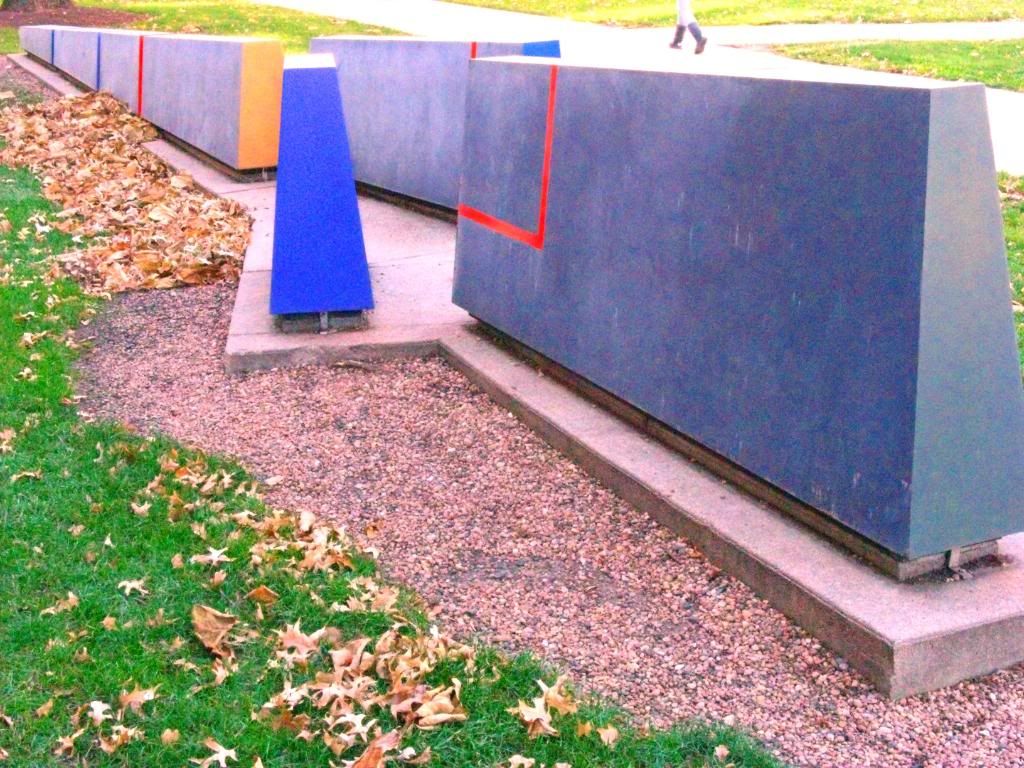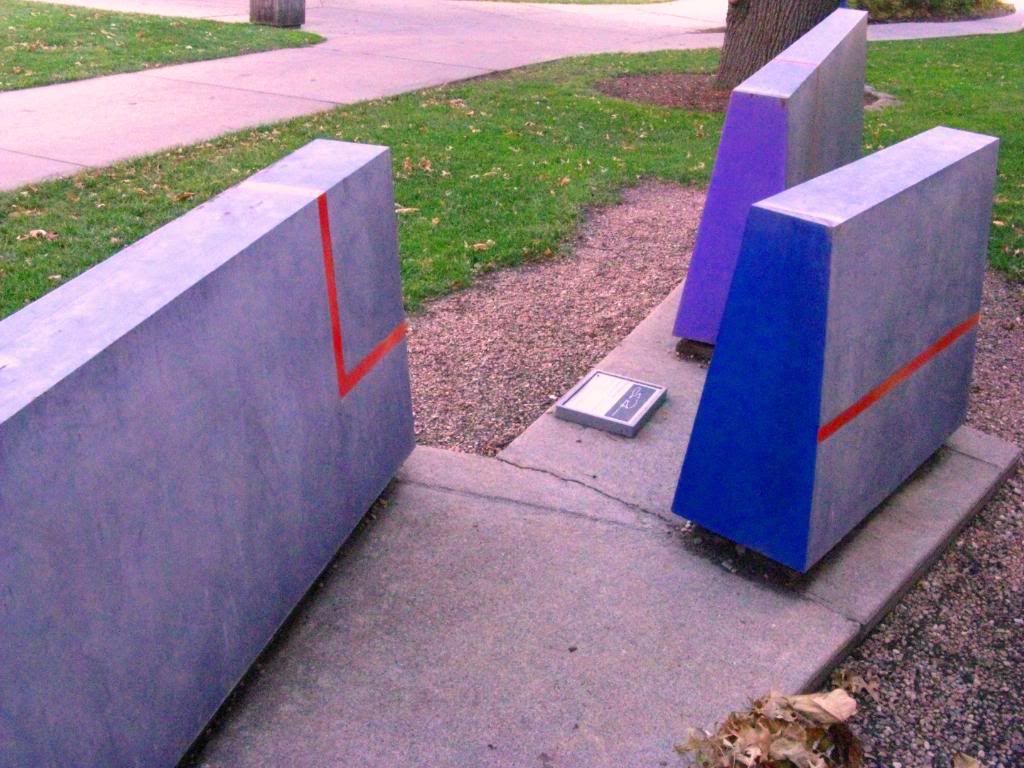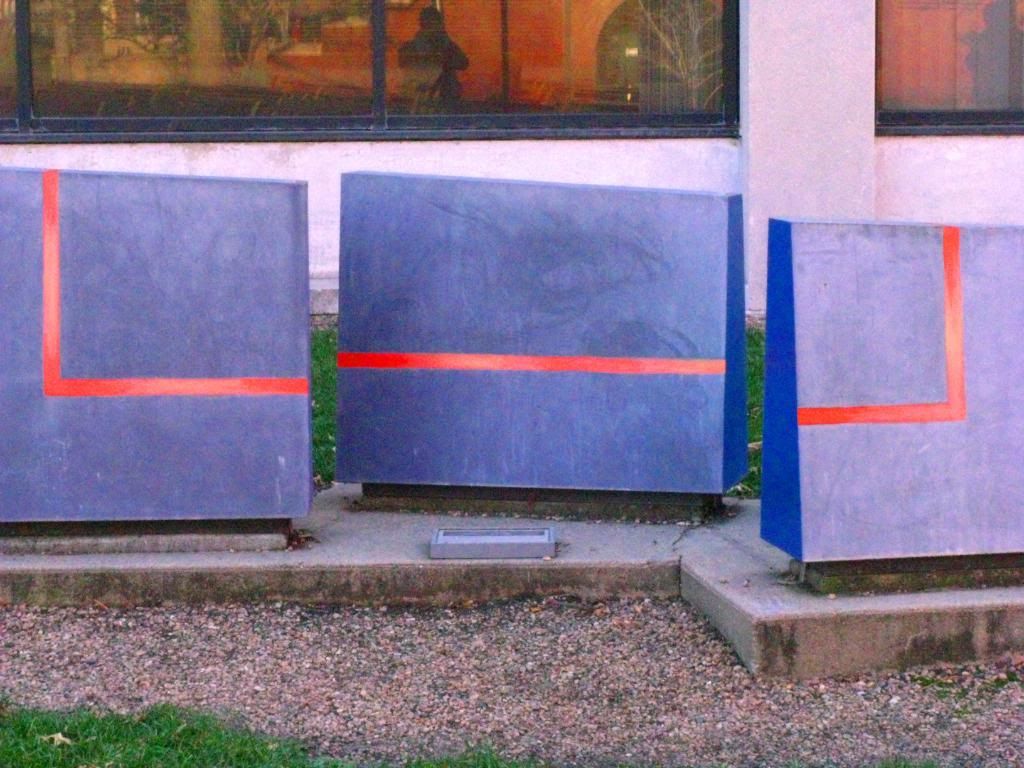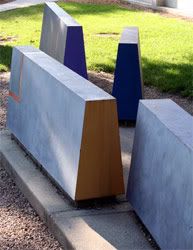This was a particularly unique assignment as it was rhetorically multidimensional. Besides simply thinking about the various elements involved when writing a rhetorical analysis, I also had to keep in mind that this was in the form of a letter that would ultimately be performed in front of an audience. This became important, as I had to specifically keep in mind my primary audience: the inanimate sculpture, as well as the secondary audience: my classmates, teacher, and other observers. In addition, I composed the letter to have a certain rhythm or feel when spoken aloud. Underlying each of these aspects, I utilized many of the rhetorical concepts learned previously in this class to form the content of the letter.
In looking rhetorically at Variable Wedge, I realize that each viewer perceives a slightly different argument from the sculpture, as it is subjective in nature. In this manner, I wanted to identify many of the main features embodied in the sculpture, which every observer would notice, and then depict why they are significant both to the piece and to me (when applicable). Furthermore, as I will be presenting this to an audience, I also employed the use of stepping-stones as an organizational device. When viewed from the West, the tops of the seven sections of the sculpture look like stepping stones progressing their way upward. Since this had a significant impact on how I viewed the piece, I felt it was fitting to use it as an organizational tool.
The general elements that I then incorporated into this seven-point argument include the form, materials, color, conflict and resolution of pattern, negative space, as well as environment (context) of the sculpture. I felt that these were important aspects to the overall design, and using logos/pathos, I described how they influenced my thought. In addition, there were several themes that I focused on throughout these seven points, the first of which centered around the second half of the sculpture’s title: a wedge. As humans, we have a tendency to see ourselves in other objects, and besides inventing the wedge as a tool, it encompasses many of our natural tendencies. As mentioned earlier, a wedge progresses through time, tapering or growing. Thus, I discussed through pathos and logos how we as humans relate to this wedge, via its general form, evolving materials, as well as progression of color.
The second major theme that is mentioned throughout the letter is that of variability. Being the other half of the sculpture’s title, this word signifies change and fluctuation, both of which are abundant throughout the sculpture. Found in the fluctuation of Variable’s form, materials, as well as environment, change is something that people relate to. Essentially, life is a series of changes over time. Whether these shifts are drastic or insignificant determine how we view them, which is similar to Variable’s changes as well. Together, the form and variability of the sculpture provide what is so unique about it: thus this is what I attempted to portray.
Final Draft:
Dear Variable Wedge,
You change, shift, and fluctuate through the passing of time. Commencing on a linear path, your form growing all the while, you reach out toward the sky. On this series of steps, I hop into the abyss. While many simplify you into a simple tool: one of six elementary instruments conceived by man, in my eyes you serve a greater purpose. You hold, split, and lift time, all in the same moment, allowing me to view the depths of my life. Then, when it appears that I have figured you out, you vary yet again, showing me something new. Angle after angle, your panoramic nature brings new insight to my soul.
 As with stepping-stones, you appear in a series of levels, each revealing bits of your character. As your first step, I notice your form: a wedge. Your positive mass takes up a slice of space in the continuous circle of time. Geometric and progressive, the fingerprint of mankind no doubt marks you. He has left you inorganic, in the shape of a tool. But perhaps you have left your mark on him as well. For, this evolution of a trapezoid reminds me of someone close, someone dear. At one point, a younger me, but upon further reflection, maybe my older self. At last, like your steps, I see continuous growth. Not only this, but a divergence from your initial path marks your maturation. Wandering left and then right, you are like my dreams: changing, shifting, fluctuating.
As with stepping-stones, you appear in a series of levels, each revealing bits of your character. As your first step, I notice your form: a wedge. Your positive mass takes up a slice of space in the continuous circle of time. Geometric and progressive, the fingerprint of mankind no doubt marks you. He has left you inorganic, in the shape of a tool. But perhaps you have left your mark on him as well. For, this evolution of a trapezoid reminds me of someone close, someone dear. At one point, a younger me, but upon further reflection, maybe my older self. At last, like your steps, I see continuous growth. Not only this, but a divergence from your initial path marks your maturation. Wandering left and then right, you are like my dreams: changing, shifting, fluctuating.
Evolving also are the materials you are made from. As a second stepping-stone, one observes your corten steel skin, which appears rigid yet vulnerable to the elements. Or is it? One may assume that you will eventually deteriorate into nothing as your surface rusts over time. Little do they know, however, that this process will only serve to strengthen you more. Your layer of rust becomes a skin of protection, chemically stable with the environment. It’s almost as if you wish to mirror our hearts and bodies. Appearing as hindrances, broken bones and wounds only serve to make us stronger.
 This brings me to your third stepping-stone, Variable Wedge: I can see your hues of experience progressing through the years. Visible but not overwhelming, these colors exist. Blue then violet. Red then yellow. As they progress, they become lighter in value. But does this build upon your previous concepts? Are the other stepping-stones related or independent? From small to large, dark to light, your form and color contain a pattern too coincidental to ignore. When I was a young boy, I was both small in stature and weak in knowledge. Like a small trapezoid in an exposed world, I was confused and uncomfortable. However, as both my strength and knowledge expanded, so did my comfort. From dark blue to a brighter yellow, I became more outgoing, mature, and bold in my actions.
This brings me to your third stepping-stone, Variable Wedge: I can see your hues of experience progressing through the years. Visible but not overwhelming, these colors exist. Blue then violet. Red then yellow. As they progress, they become lighter in value. But does this build upon your previous concepts? Are the other stepping-stones related or independent? From small to large, dark to light, your form and color contain a pattern too coincidental to ignore. When I was a young boy, I was both small in stature and weak in knowledge. Like a small trapezoid in an exposed world, I was confused and uncomfortable. However, as both my strength and knowledge expanded, so did my comfort. From dark blue to a brighter yellow, I became more outgoing, mature, and bold in my actions.
 Hold on a moment, though. From dark to light, your pattern holds strong. Why then, do you resort back to blue and violet while you are still growing? At this same juncture, your form expands. Moving left and then right, it sways back and forth. Now, my good friend Variable, I question what I have constructed. You have wedged this problem into my stream of consciousness: splitting and testing what I thought I knew. For when life is easy, and things are going as planned, confidence is gained and boldness harvested. Ultimately, though, as you break your norms, conflict seizes this comfort. Inevitably, youthful feelings of inexperience emerge once again, regressing your emotions to a previous state. Combining the bright hues of your previous knowledge and experience, however, you piece yourself together. In this entire process you also gain knowledge about yourself, as well as the meaning of an orange rectangle and color regression on a sculpture.
Hold on a moment, though. From dark to light, your pattern holds strong. Why then, do you resort back to blue and violet while you are still growing? At this same juncture, your form expands. Moving left and then right, it sways back and forth. Now, my good friend Variable, I question what I have constructed. You have wedged this problem into my stream of consciousness: splitting and testing what I thought I knew. For when life is easy, and things are going as planned, confidence is gained and boldness harvested. Ultimately, though, as you break your norms, conflict seizes this comfort. Inevitably, youthful feelings of inexperience emerge once again, regressing your emotions to a previous state. Combining the bright hues of your previous knowledge and experience, however, you piece yourself together. In this entire process you also gain knowledge about yourself, as well as the meaning of an orange rectangle and color regression on a sculpture.
This conflict and resolution were the fourth and fifth steps; they added much to your emerging character. And with these additions, I thought our relationship had been discovered. As is evidenced by many things in this world, however, your being is more complex than simply the obvious. Just as a wedge has many uses and is constantly changing, so too are your defining elements. While your positive form occupies a slice of space and contains billions of molecules, it fails to occupy even a fraction of the universe. Surrounding you are, thus, an infinite number of other variables, each of which contribute to your ever-changing being. Just as they interact with the wavelengths of your colors and the toughness of your skin, they also define the edges of your form. As steel turns to air, air tapers to steel, positive and negative wedges interact.
These other forms of wedges exist and become the sixth stone to step on, further establishing your character. The negative spaces between your sections juxtapose the finite and definable qualities of your positive form. These are your wedges that are truly variable, constantly changing. In one moment, an insect dissects this space, while in the next it is filled with the decomposition of leaves. I believe this is one of the more complicated aspects of you, Variable, and I don’t intend to pretend I know everything about it.
In continuing with this theme, the seventh and final stone forming your character is not about you, but about your environment. Essential to any being are their orientation among their surrounding elements. In your case, there are two buildings that run parallel to your body, representing professional occupations. In music and architecture, change is necessary, as originality is key. Even broader than this is the fact that you are on a university campus: a place where dreams are formed, futures molded. Variability is synonymous with this collegiate atmosphere, as students’ lives are constantly shifting. From a change in major, to a flux in ones beliefs, it is a time of self-identification. In this way, your physical features are defined more by these facts than by their own mass.
As we have spent these past weeks together, Variable, each of your encompassing elements has suggested much to me. Your form, material, and color provided a base, while the conflict and resolution of pattern pushed my thinking. Then I realized the impact of the negative space and environment on your story. They build upon one another, adding layers of insight reaching to the heavens. However, as I have identified these seven areas, I realize that I have only scratched the surface of your variability. As such, I wish only to imitate you for a moment, starting at the beginning of your path upwards. Perhaps I will gain more of your wisdom this way.
Sincerely,
Joey Laughlin